Abstract
RNase A introduced into the cytoplasm of IMR-90 human diploid fibroblasts by erythrocyte-mediated microinjection is degraded with a half-life of approximately equal to 75 hr in the presence of fetal bovine serum. In response to serum deprivation the degradative rate of microinjected RNase A is enhanced 2-fold. RNase S protein (amino acids 21-124) is degraded with a half-life similar to that of RNase A in the presence of serum, but its catabolism is not increased during serum withdrawal. Reconstitution of RNase S protein with RNase S peptide (amino acids 1-20) restored full enzymatic activity to the S protein as well as the ability of fibroblasts to increase its catabolism during serum deprivation. Finally, RNase S peptide microinjected alone shows the full 2-fold increase in degradative rate during serum withdrawal. These results show that recognition of RNase A for enhanced breakdown during serum deprivation is based on some feature of its amino-terminal 20 amino acids. Furthermore, our results indicate that the enhanced protein catabolism during serum deprivation can be highly selective.
Full text
PDF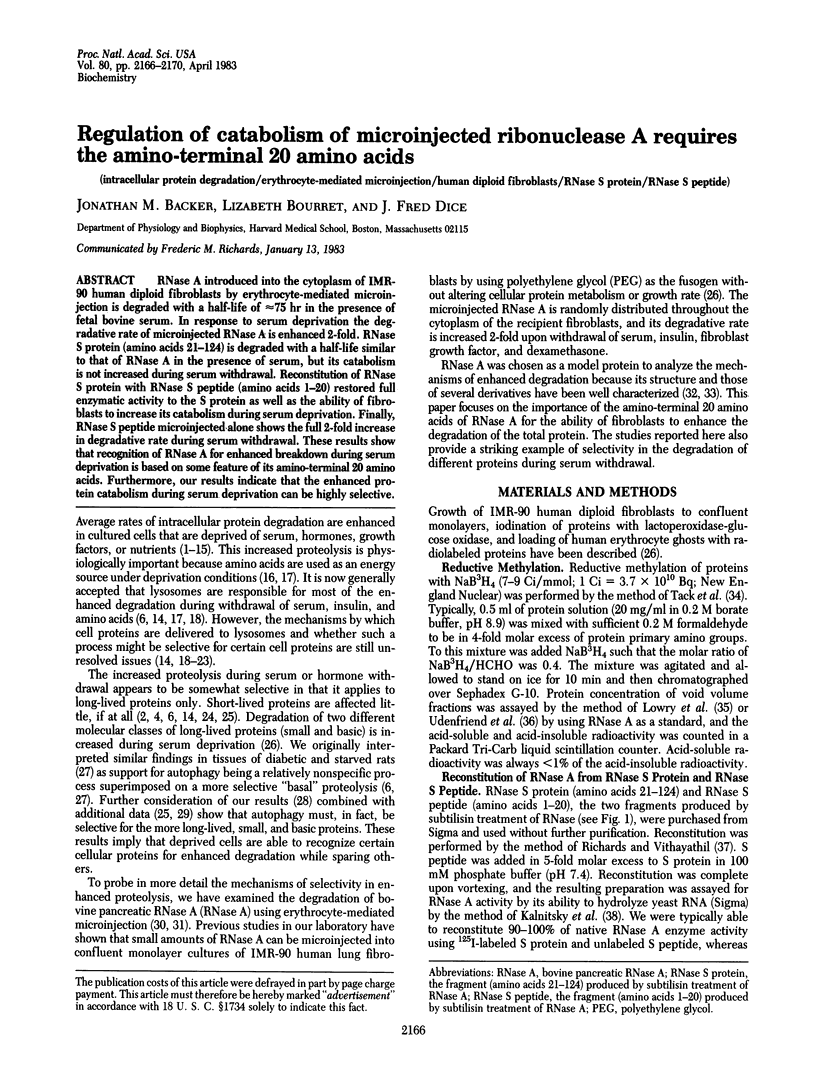
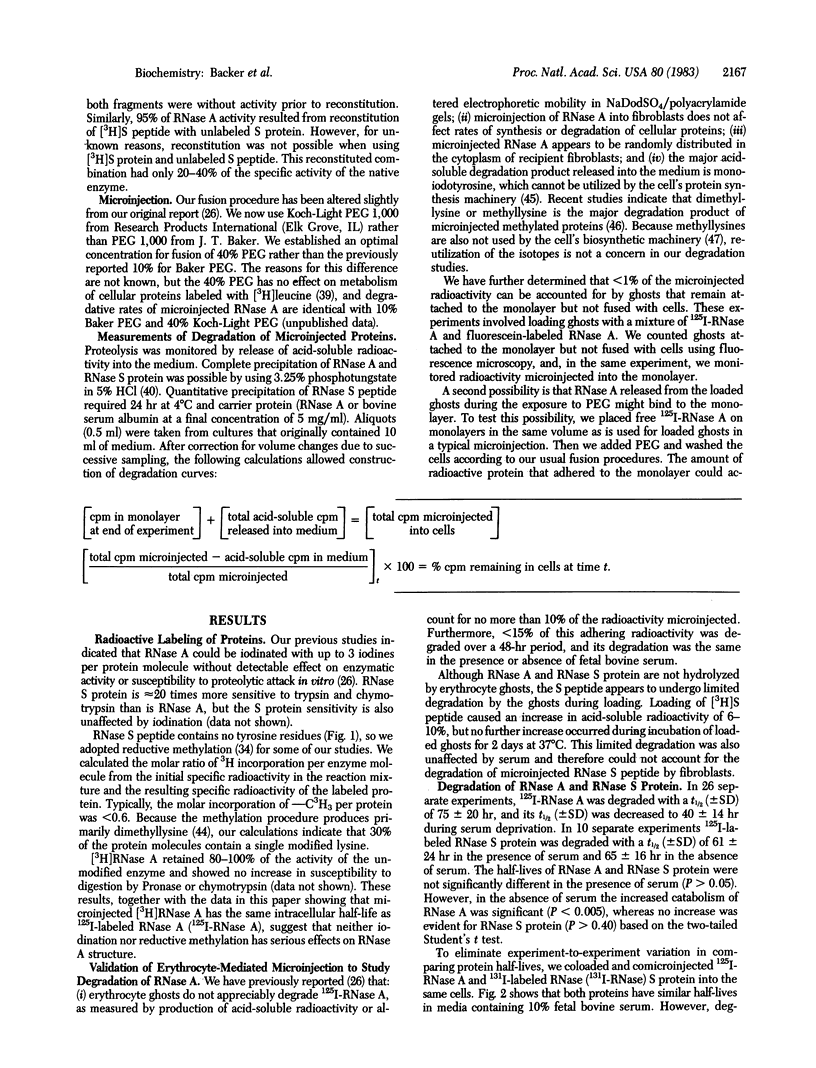
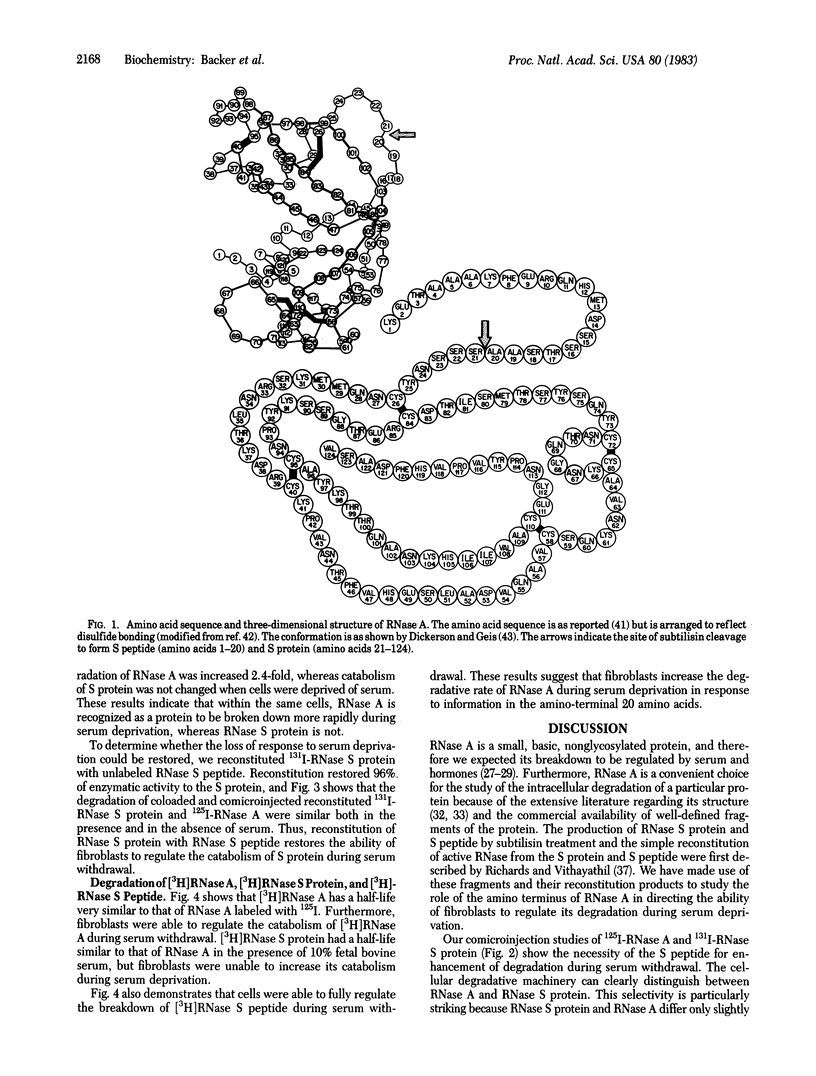
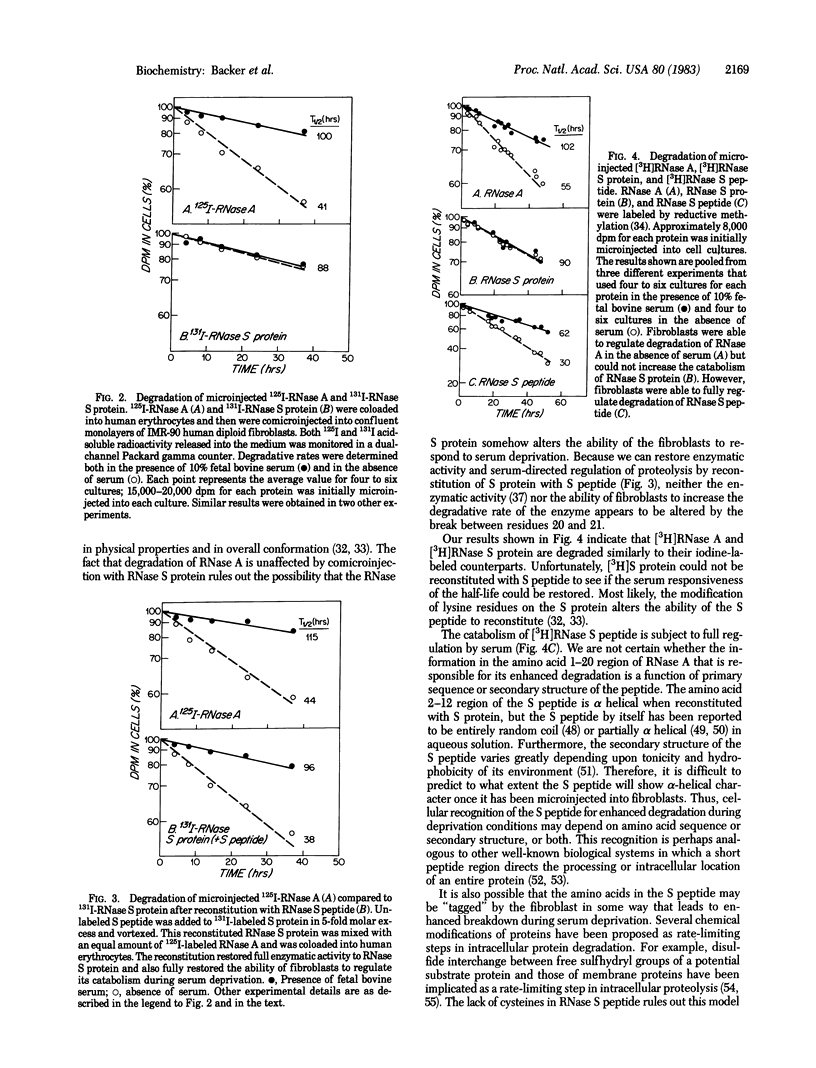
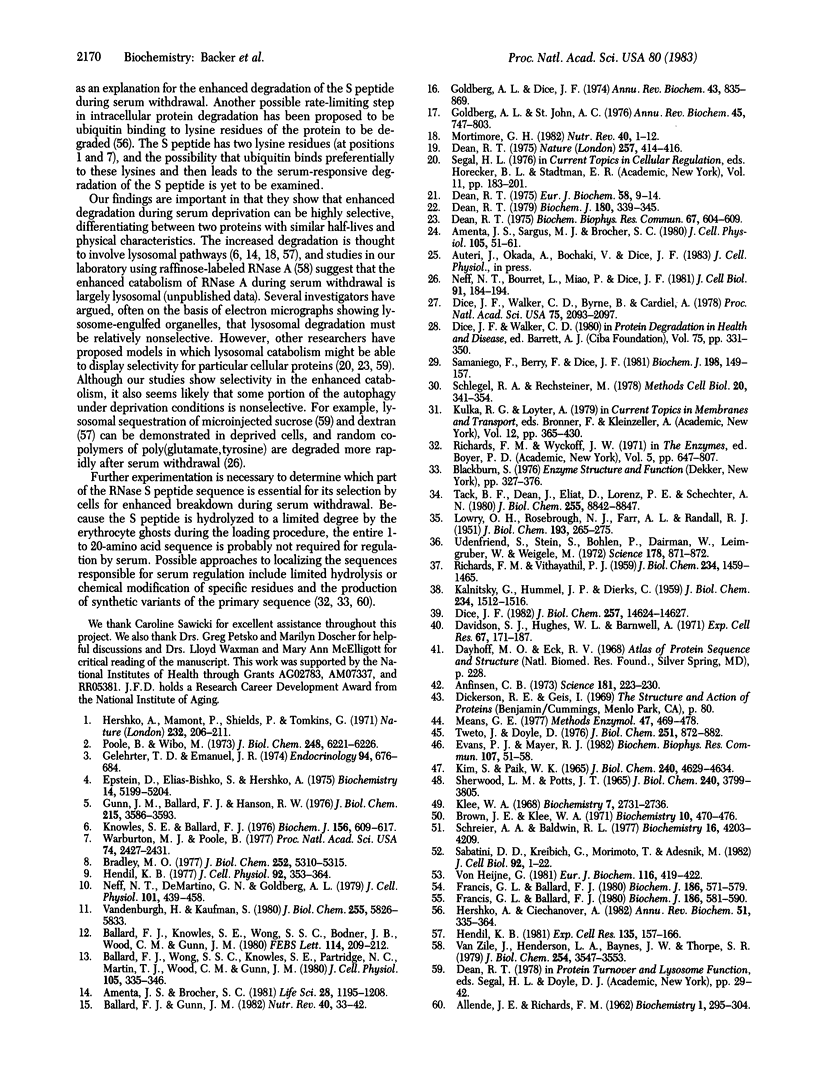
Selected References
These references are in PubMed. This may not be the complete list of references from this article.
- ALLENDE J. E., RICHARDS F. M. The action of trypsin on ribonuclease-S. Biochemistry. 1962 Mar;1:295–304. doi: 10.1021/bi00908a017. [DOI] [PubMed] [Google Scholar]
- Amenta J. S., Brocher S. C. Mechanisms of protein turnover in cultured cells. Life Sci. 1981 Mar 16;28(11):1195–1208. doi: 10.1016/0024-3205(81)90444-6. [DOI] [PubMed] [Google Scholar]
- Amenta J. S., Sargus M. J., Brocher S. C. Protein synthesis and degradation in growth regulation in rat embryo fibroblasts: role of fast-turnover and slow-turnover protein. J Cell Physiol. 1980 Oct;105(1):51–61. doi: 10.1002/jcp.1041050108. [DOI] [PubMed] [Google Scholar]
- Anfinsen C. B. Principles that govern the folding of protein chains. Science. 1973 Jul 20;181(4096):223–230. doi: 10.1126/science.181.4096.223. [DOI] [PubMed] [Google Scholar]
- Ballard F. J., Knowles S. E., Wong S. S., Bodner J. B., Wood C. M., Gunn J. M. Inhibition of protein breakdown in cultured cells is a consistent response to growth factors. FEBS Lett. 1980 Jun 2;114(2):209–212. doi: 10.1016/0014-5793(80)81116-1. [DOI] [PubMed] [Google Scholar]
- Ballard F. J., Wong S. S., Knowles S. E., Partridge N. C., Martin T. J., Wood C. M., Gunn J. M. Insulin inhibition of protein degradation in cell monolayers. J Cell Physiol. 1980 Nov;105(2):335–346. doi: 10.1002/jcp.1041050216. [DOI] [PubMed] [Google Scholar]
- Bradley M. O. Regulation of protein degradation in normal and transformed human cells. Effects of growth state, medium composition, and viral transformation. J Biol Chem. 1977 Aug 10;252(15):5310–5315. [PubMed] [Google Scholar]
- Brown J. E., Klee W. A. Helix-coil transition of the isolated amino terminus of ribonuclease. Biochemistry. 1971 Feb 2;10(3):470–476. doi: 10.1021/bi00779a019. [DOI] [PubMed] [Google Scholar]
- Davidson S. J., Hughes W. L., Barnwell A. Renal protein absorption into sub-cellular particles. I. Studies with intact kidneys and fractionated homogenates. Exp Cell Res. 1971 Jul;67(1):171–187. doi: 10.1016/0014-4827(71)90633-1. [DOI] [PubMed] [Google Scholar]
- Dean R. T. Concerning a possible mechanism for selective capture of cytoplasmic proteins by lysosomes. Biochem Biophys Res Commun. 1975 Nov 17;67(2):604–609. doi: 10.1016/0006-291x(75)90855-4. [DOI] [PubMed] [Google Scholar]
- Dean R. T. Direct evidence of importance of lysosomes in degradation of intracellular proteins. Nature. 1975 Oct 2;257(5525):414–416. doi: 10.1038/257414a0. [DOI] [PubMed] [Google Scholar]
- Dean R. T. Lysosomal enzymes as agents of turnover of soluble cytoplasmic proteins. Eur J Biochem. 1975 Oct 1;58(1):9–14. doi: 10.1111/j.1432-1033.1975.tb02342.x. [DOI] [PubMed] [Google Scholar]
- Dean R. T. Macrophage protein turnover. Evidence for lysosomal participation in basal proteolysis. Biochem J. 1979 May 15;180(2):339–345. doi: 10.1042/bj1800339. [DOI] [PMC free article] [PubMed] [Google Scholar]
- Dice J. F. Altered degradation of proteins microinjected into senescent human fibroblasts. J Biol Chem. 1982 Dec 25;257(24):14624–14627. [PubMed] [Google Scholar]
- Dice J. F., Walker C. D., Byrne B., Cardiel A. General characteristics of protein degradation in diabetes and starvation. Proc Natl Acad Sci U S A. 1978 May;75(5):2093–2097. doi: 10.1073/pnas.75.5.2093. [DOI] [PMC free article] [PubMed] [Google Scholar]
- Epstein D., Elias-Bishko S., Hershko A. Requirement for protein synthesis in the regulation of protein breakdown in cultured hepatoma cells. Biochemistry. 1975 Nov 18;14(23):5199–5204. doi: 10.1021/bi00694a028. [DOI] [PubMed] [Google Scholar]
- Evans P. J., Mayer R. J. Organelle membrane-cell fusion: destruction of transplanted mitochondrial proteins in hepatocyte monolayers. Biochem Biophys Res Commun. 1982 Jul 16;107(1):51–58. doi: 10.1016/0006-291x(82)91668-0. [DOI] [PubMed] [Google Scholar]
- Francis G. L., Ballard F. J. Distribution and partial purification of a liver membrane protein capable of inactivating cytosol enzymes. Biochem J. 1980 Feb 15;186(2):571–579. doi: 10.1042/bj1860571. [DOI] [PMC free article] [PubMed] [Google Scholar]
- Francis G. L., Ballard F. J. Enzyme inactivation via disulphide-thiol exchange as catalysed by a rat liver membrane protein. Biochem J. 1980 Feb 15;186(2):581–590. doi: 10.1042/bj1860581. [DOI] [PMC free article] [PubMed] [Google Scholar]
- Gelehrter T. D., Emanuel J. R. Hormonal regulation of protein degradation in hepatoma cells in tissue culture. Endocrinology. 1974 Mar;94(3):676–684. doi: 10.1210/endo-94-3-676. [DOI] [PubMed] [Google Scholar]
- Goldberg A. L., Dice J. F. Intracellular protein degradation in mammalian and bacterial cells. Annu Rev Biochem. 1974;43(0):835–869. doi: 10.1146/annurev.bi.43.070174.004155. [DOI] [PubMed] [Google Scholar]
- Goldberg A. L., St John A. C. Intracellular protein degradation in mammalian and bacterial cells: Part 2. Annu Rev Biochem. 1976;45:747–803. doi: 10.1146/annurev.bi.45.070176.003531. [DOI] [PubMed] [Google Scholar]
- Gunn J. M., Ballard F. J., Hanson R. W. Infulence of hormones and medium composition on the degradation of phosphoenolpyruvate carboxykinase (GTP) and total protein in Reuber H35 cells. J Biol Chem. 1976 Jun 25;251(12):3586–3593. [PubMed] [Google Scholar]
- Hendil K. B. Autophagy of metabolically inert substances injected into fibroblasts in culture. Exp Cell Res. 1981 Sep;135(1):157–166. doi: 10.1016/0014-4827(81)90308-6. [DOI] [PubMed] [Google Scholar]
- Hendil K. B. Intracellular protein degradation in growing, in density-inhibited, and in serum-restricted fibroblast cultures. J Cell Physiol. 1977 Sep;92(3):353–364. doi: 10.1002/jcp.1040920304. [DOI] [PubMed] [Google Scholar]
- Hershko A., Ciechanover A. Mechanisms of intracellular protein breakdown. Annu Rev Biochem. 1982;51:335–364. doi: 10.1146/annurev.bi.51.070182.002003. [DOI] [PubMed] [Google Scholar]
- Hershko A., Mamont P., Shields R., Tomkins G. M. "Pleiotypic response". Nat New Biol. 1971 Aug;232(33):206–211. [PubMed] [Google Scholar]
- KALNITSKY G., HUMMEL J. P., DIERKS C. [Some factors which affect the enzymatic digestion of ribonucleic acid]. J Biol Chem. 1959 Jun;234(6):1512–1516. [PubMed] [Google Scholar]
- Kim S., Paik W. K. Studies on the origin of epsilon-N-methyl-L-lysine in protein. J Biol Chem. 1965 Dec;240(12):4629–4634. [PubMed] [Google Scholar]
- Klee W. A. Studies on the conformation of ribonuclease S-peptide. Biochemistry. 1968 Aug;7(8):2731–2736. doi: 10.1021/bi00848a006. [DOI] [PubMed] [Google Scholar]
- Knowles S. E., Ballard F. J. Selective control of the degradation of normal and aberrant proteins in Reuber H35 hepatoma cells. Biochem J. 1976 Jun 15;156(3):609–617. doi: 10.1042/bj1560609. [DOI] [PMC free article] [PubMed] [Google Scholar]
- LOWRY O. H., ROSEBROUGH N. J., FARR A. L., RANDALL R. J. Protein measurement with the Folin phenol reagent. J Biol Chem. 1951 Nov;193(1):265–275. [PubMed] [Google Scholar]
- Means G. E. Reductive alkylation of amino groups. Methods Enzymol. 1977;47:469–478. doi: 10.1016/0076-6879(77)47047-2. [DOI] [PubMed] [Google Scholar]
- Neff N. T., Bourret L., Miao P., Dice J. F. Degradation of proteins microinjected into IMR-90 human diploid fibroblasts. J Cell Biol. 1981 Oct;91(1):184–194. doi: 10.1083/jcb.91.1.184. [DOI] [PMC free article] [PubMed] [Google Scholar]
- Neff N. T., DeMartino G. N., Goldberg A. L. The effect of protease inhibitors and decreased temperature on the degradation of different classes of proteins in cultured hepatocytes. J Cell Physiol. 1979 Dec;101(3):439–457. doi: 10.1002/jcp.1041010311. [DOI] [PubMed] [Google Scholar]
- Poole B., Wibo M. Protein degradation in cultured cells. The effect of fresh medium, fluoride, and iodoacetate on the digestion of cellular protein of rat fibroblasts. J Biol Chem. 1973 Sep 10;248(17):6221–6226. [PubMed] [Google Scholar]
- RICHARDS F. M., VITHAYATHIL P. J. The preparation of subtilisn-modified ribonuclease and the separation of the peptide and protein components. J Biol Chem. 1959 Jun;234(6):1459–1465. [PubMed] [Google Scholar]
- Sabatini D. D., Kreibich G., Morimoto T., Adesnik M. Mechanisms for the incorporation of proteins in membranes and organelles. J Cell Biol. 1982 Jan;92(1):1–22. doi: 10.1083/jcb.92.1.1. [DOI] [PMC free article] [PubMed] [Google Scholar]
- Samaniego F. C., Berry F., Dice J. F. Selective depletion of small basic non-glycosylated proteins in diabetes. Biochem J. 1981 Jul 15;198(1):149–157. doi: 10.1042/bj1980149. [DOI] [PMC free article] [PubMed] [Google Scholar]
- Schlegel R. A., Rechsteiner M. C. Red cell-mediated microinjection of macromolecules into mammalian cells. Methods Cell Biol. 1978;20:341–354. doi: 10.1016/s0091-679x(08)62026-9. [DOI] [PubMed] [Google Scholar]
- Schreier A. A., Baldwin R. L. Mechanism of dissociation of S-peptide from ribonuclease S. Biochemistry. 1977 Sep 20;16(19):4203–4209. doi: 10.1021/bi00638a012. [DOI] [PubMed] [Google Scholar]
- Sherwood L. M., Potts J. T., Jr Conformational studies of pancreatic ribonuclease and its subtilisin-produced derivatives. J Biol Chem. 1965 Oct;240(10):3799–3805. [PubMed] [Google Scholar]
- Tack B. F., Dean J., Eilat D., Lorenz P. E., Schechter A. N. Tritium labeling of proteins to high specific radioactivity by reduction methylation. J Biol Chem. 1980 Sep 25;255(18):8842–8847. [PubMed] [Google Scholar]
- Tweto J., Doyle D. Turnover of the plasma membrane proteins of hepatoma tissue culture cells. J Biol Chem. 1976 Feb 10;251(3):872–882. [PubMed] [Google Scholar]
- Udenfriend S., Stein S., Böhlen P., Dairman W., Leimgruber W., Weigele M. Fluorescamine: a reagent for assay of amino acids, peptides, proteins, and primary amines in the picomole range. Science. 1972 Nov 24;178(4063):871–872. doi: 10.1126/science.178.4063.871. [DOI] [PubMed] [Google Scholar]
- Van Zile J., Henderson L. A., Baynes J. W., Thorpe S. R. [3H]Raffinose, a novel radioactive label for determining organ sites of catabolism of proteins in the circulation. J Biol Chem. 1979 May 10;254(9):3547–3553. [PubMed] [Google Scholar]
- Vandenburgh H., Kaufman S. Protein degradation in embryonic skeletal muscle. Effect of medium, cell type, inhibitors, and passive stretch. J Biol Chem. 1980 Jun 25;255(12):5826–5833. [PubMed] [Google Scholar]
- Warburton M. J., Poole B. Effect of medium composition on protein degradation and DNA synthesis in rat embryo fibroblasts. Proc Natl Acad Sci U S A. 1977 Jun;74(6):2427–2431. doi: 10.1073/pnas.74.6.2427. [DOI] [PMC free article] [PubMed] [Google Scholar]
- von Heijne G. On the hydrophobic nature of signal sequences. Eur J Biochem. 1981 May 15;116(2):419–422. doi: 10.1111/j.1432-1033.1981.tb05351.x. [DOI] [PubMed] [Google Scholar]


